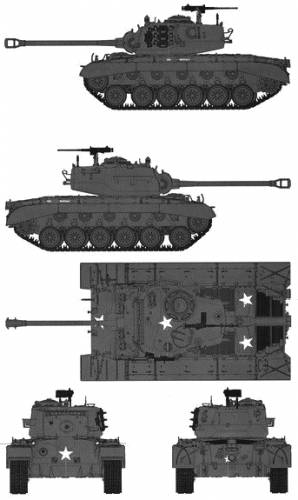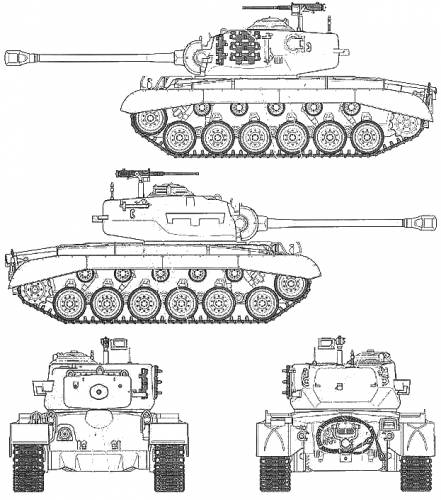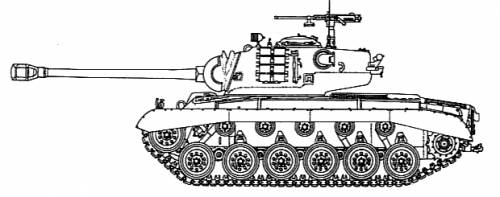History:
The Pershing was the first operational heavy tank of the United States Army. It was classified as a heavy tank when it was designed in WWII due to its 90mm gun, which was at the time the largest caliber gun found on an American tank. In 1957, the U.S. developed the M103 tank, which had an even larger 120mm gun, and the M26 Pershing was re-classified as a medium tank. The tank is named after General John J. Pershing who led the American Expeditionary Force in Europe in World War I. It was briefly used both in World War II and in the Korean War.
Intended as an improvement of the M4 Sherman, the prolonged time of development meant that only a small number saw combat in the European theater, most notably in the 9th Armored Division's dramatic dash to take the Bridge at Remagen. In combat it was, unlike the M4 Sherman, fairly equal in firepower and protection to both the Tiger I and Panther tanks, but was underpowered and mechanically unreliable. This became even more evident in the Korean War, where the M26, while an overmatch for the T-34-85, had severe problems with the hilly terrain and was withdrawn in 1951 in favor of its improved derivative, the M46 Patton, which had a more powerful and reliable engine. The lineage of the M26 continued with the M47 Patton, and was reflected in the new designs of the later M48 Patton and M60 Patton.
  |
M26 Pershing blueprints
The M26 was the culmination of a series of tank prototypes that began with the T20 in 1942 and represented a significant design departure from the previous line of U.S. Army tanks that had ended with the M4 Sherman; a number of design features were tested in the various prototypes, some of which were experimental dead-ends, but many of which would become permanent characteristics of subsequent modern U.S. Army tanks. The prototype series began as a medium tank upgrade of the M4 Sherman and ended as the U.S. Army's first operational heavy tank.
The 90-mm M3 gun of the Pershing was similar to the German 88 mm KwK 36 used on the Tiger I. In an effort to match the firepower of the Tiger II's more powerful 88 mm KwK43, the T15E1 90 mm gun was developed and mounted in a T26E1 in January 1945. This tank was designated T26E1-1. The T15E1 gun was 73 calibers in length and had a much longer high-capacity chamber. This gave it a muzzle velocity of 3,750 ft/s (1,140 m/s) with the T30E16 APCR shot and could penetrate the Panther's frontal armor at up to 2,600 yd (2,400 m). This model used single-piece 50-inch-long (1,300 mm) ammunition and was the only Super Pershing sent to Europe.
A second pilot tank was converted from a T26E3 and used a modified T15E2 gun that had two-piece ammunition. Twenty five of these tanks were built and designated as the T26E4. An improved mounting removed the need for stabilizer springs.
Post-war, two M26 tanks had the T54 gun installed, which had the same long gun barrel, but the ammunition cartridge was designed to be shorter and fatter, while still retaining the propellant force of the original round. They also had the muzzle brake and bore evacuator from the M3A1 gun of the M26A1 and M46. The tanks were designated as the M26E1 tank, but lack of funds cut off further production.
- M26 (T26E3). M3 gun with double-baffle muzzle brake. Main production model.
- M26A1. M3A1 gun with bore evacuator and single-baffle muzzle brake.
- T26E1-1 (T26E4-1 or M26A1E2). Version armed with a T15E1 large exterior stabilizer springs single piece ammo (used in combat).
- T26E4. Experimental version armed with a long T15E2 gun two-part ammunition, improved mounting removed the need for springs.
- M26E1. Longer gun, single-part ammunition T54 gun. (post war)
- M26E2. New engine and transmission and M3A1 gun. Ended up as the M46 Patton. (post war)
- T26E2, eventually standardized for use as the Heavy Tank M45 — a close support vehicle with a 105 mm howitzer (74 rounds).
- T26E5. Prototype with thicker armor — a maximum of 279 mm.
|





No comments:
Post a Comment